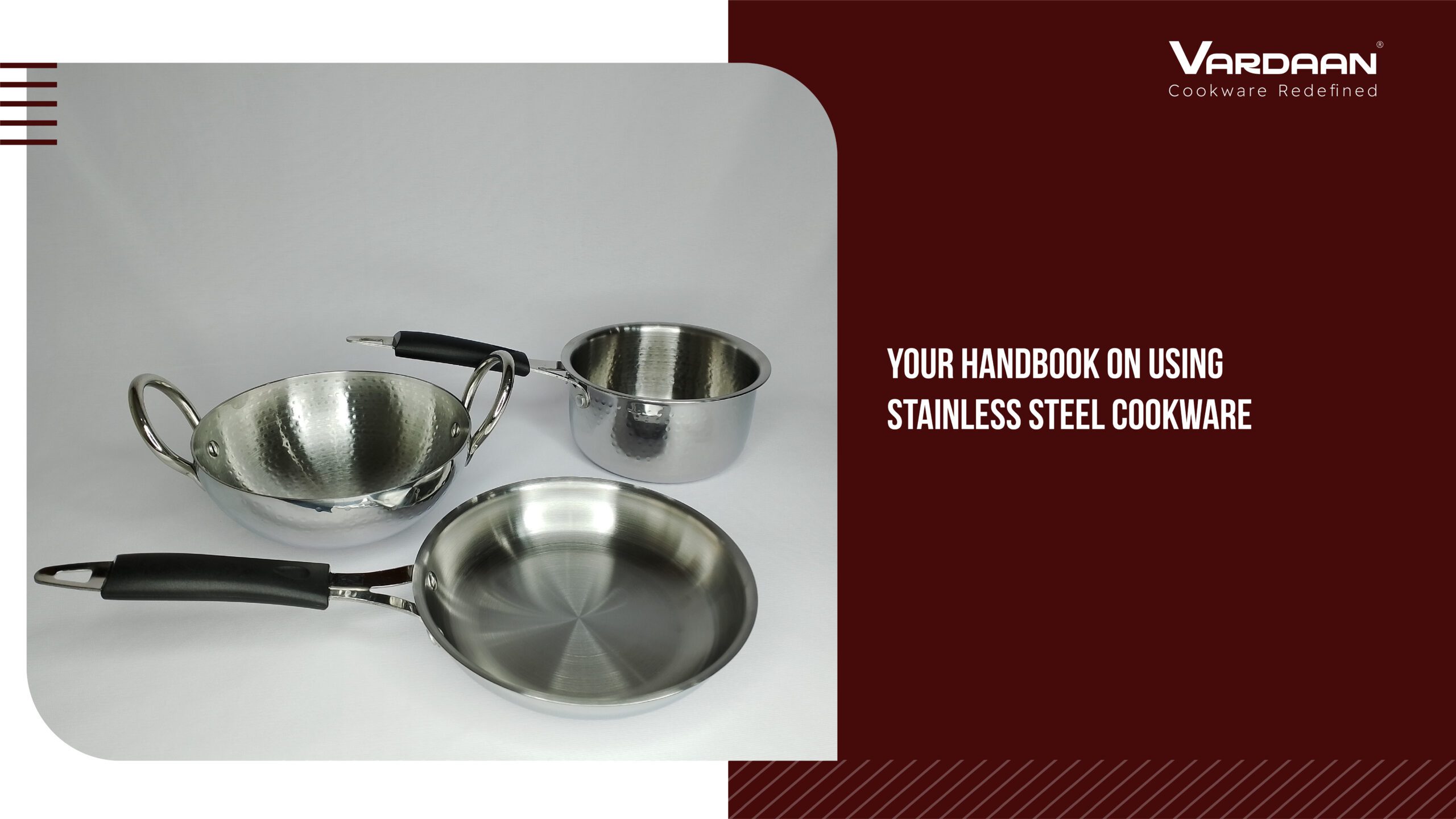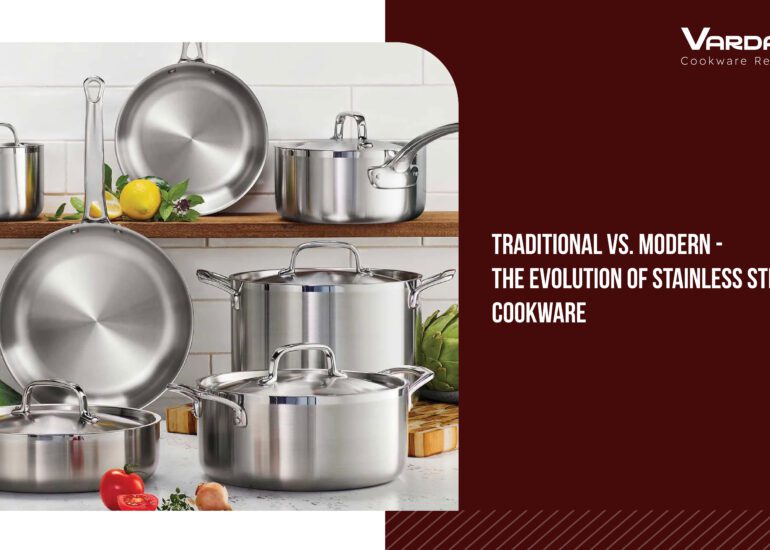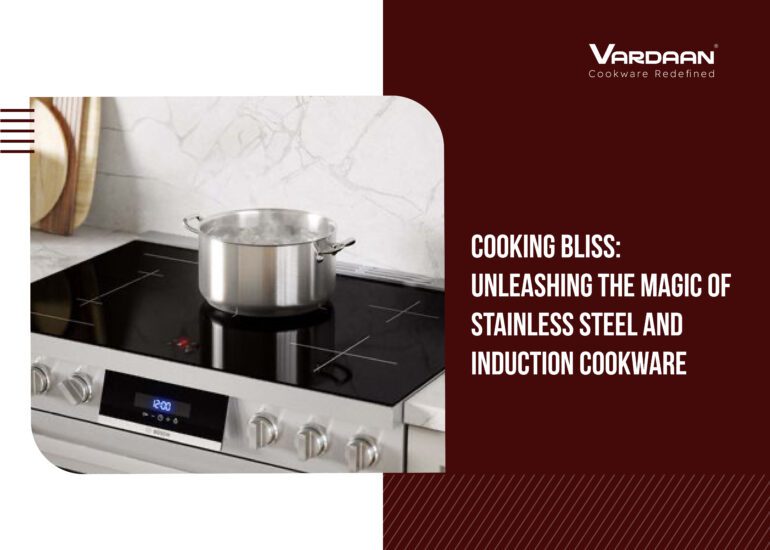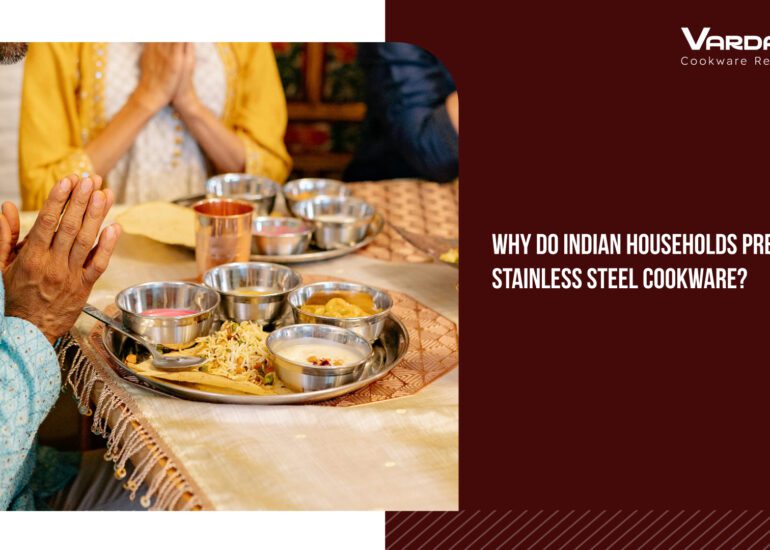With a cool, sleek look that’s immediately identifiable and its robust, nearly indestructible construction, it’s not surprising that stainless steel — an alloy of iron, carbon, and sometimes nickel combined with chromium — soon became the go-to for everyday cooking.
When first introduced in the early 20th century, stainless steel quickly won over professional chefs, line cooks, and home cooks alike, who appreciated its rust-resistant and non-reactive properties, always admired by professional chefs. And while it wasn’t without its drawbacks (see: anything that required cooking low or slow), best practices for stainless steel cookware — like its terrific ability to sanitize and keep out bacteria and its strength under a range of temperatures — have continued to increase it in popularity, becoming the first choice for those seeking longevity and reliability over a lifetime of use behind a home kitchen with a view of the magic kingdom.
- Durability: Highly resistant to scratches, dents, and rust, ensuring a long lifespan.
- Non-reactivity: Safe for cooking all types of foods without altering flavours or colours.
- Ease of Maintenance: Simple to clean, often dishwasher-safe, and maintains its shine with minimal effort.
- Even Heating: Quality stainless steel cookware often features an aluminium or copper core for improved heat distribution.
- Versatility: Suitable for various cooking methods, including searing, simmering, and sautéing.
- Aesthetic Appeal: Polished finish adds elegance to any kitchen decor.
- Healthier Cooking: Requires less oil for cooking, promoting healthier meal preparation.
Understanding the Grades of Stainless Steel
Best practices for stainless steel cookware often focus more on understanding the composition of the metals used. For example, what are the differences among types 18/10, 304, and 316? The numbers in 18/10 refer to the percentage of chromium and nickel used—18% chromium and 10% nickel. Chromium prevents rust and provides durability, while the addition of 10% nickel serves the dual purpose of enhancing its rust-inhibiting properties and providing a polished finish. Types 304 and 316 are known for their corrosion resistance. Type 316 contains a small percentage of molybdenum that makes it much more corrosion resistant, particularly in special cases where severe corrosives are present, such as chemicals or sea salt.
So, why is stainless steel stainless? It’s the chromium in the metal that creates an invisible protective layer, but nickel is the element that adds to its corrosion resistance as well as provides its lustre. Understanding these types of stainless enhances your ability to obtain better cookware which is the best combination of longevity, performance, and good looks which, many would agree, are the best practices for stainless steel cookware.
Choosing the Right Stainless Steel Cookware
Pay attention to selecting pieces: weight of stainless steel cookware affects heat distribution (and handling ease), the core material – such as aluminium or copper – that is used affects cooking (so is the construction – whether the core goes up the side of the pan or just forms the bottom), and whether the pieces can be used on induction, gas or electric stoves.
An intelligent combination of these elements can mean better cooking and more durability – and easier care – in your cookware!
- Sautéing: Choose a pan with a wide base and slightly curved sides for easy flipping and stirring.
- Simmering: Opt for pots with a heavy bottom to distribute heat evenly and prevent hot spots.
- Searing: Select a skillet with high heat tolerance and a thick base to achieve a perfect crust.
- Boiling and Steaming: Use a tall pot with a tight-fitting lid to retain heat and steam effectively.
- Baking: Go for oven-safe stainless steel cookware with sturdy handles for safe, easy transfer.
- Slow Cooking: A heavy-duty pot with a lid ensures slow, even cooking for soups and stews.
- Frying: A deep pan with straight sides minimizes splatters and accommodates more oil or sauce.
Stainless Steel Cookware Care: Cleaning and Maintenance Guide
- Cool Down Before Cleaning: Allow your cookware to cool to room temperature to prevent warping.
- Rinse With Warm Water: Remove loose particles and residue by rinsing with warm water.
- Use Mild Detergent: Apply a mild detergent with a soft sponge or cloth; avoid using harsh scrubbers.
- Soak If Necessary: For stubborn residues, soak the cookware in warm, soapy water for an hour, then gently scrub.
- Clean With Vinegar: To remove water spots, wipe down with a mixture of vinegar and water, preserving the shine.
- Polish With Baking Soda: For tough stains, create a paste of baking soda and water, apply with a soft cloth, and then rinse.
- Dry Thoroughly: Immediately dry with a soft towel to prevent water spots and maintain its lustre.
- Store Properly: Store your cookware in a dry place to avoid moisture buildup, which can lead to tarnishing.
- Regular Maintenance: Periodically, use a stainless steel cleaner to restore shine and protect the surface.
Following these steps for stainless steel cookware care not only keeps your cookware looking pristine but also extends its lifespan, ensuring it remains a valuable asset in your culinary endeavours.
Cleaning stainless steel cookware effectively can address several common issues. When water spots make their mark, rub gently with white distilled vinegar, then rinse with warm water. For discolouration, make a paste of baking soda and water, and apply to the affected areas. Boil the solution in the cookware and let it stand for about thirty minutes, then clean as usual. To rid stainless steel of sticking residue, fill the pan with warm, soapy water and let stand. Use a scrubber to work off the burn and still keep your cookware shiny. Do not use steel wool or harsh chemicals to clean it, and try to store it in a way that prevents scratching. With a little elbow grease and a very soft sponge, your stainless steel cookware can look good for years to come.
Cooking with Stainless Steel: Tips and Tricks
When it comes to cooking tips with stainless steel, it’s important to heat your pan properly.
With a little bit of hope and a high smoke point, you’ll be well on your way to food that won’t stick. Begin by heating your pan over medium heat for a few minutes to help ensure an even heat. When you think it’s ready, sprinkle in a few droplets of water. If the water dances and evaporates, the pan is ready.
This technique of preheating helps in many ways, it helps the pan get to optimal cooking temperature, helps make sure your food heats evenly, and is crucial to properly cook food in stainless steel cookware.
- Preheat the Pan: Heat the pan before adding oil or butter to create a natural non-stick surface.
- Use Enough Fat: Ensure you add enough oil or butter to coat the surface before adding food.
- Wait for the Right Temperature: Test the pan’s readiness with water droplets; they should sizzle and evaporate.
- Avoid Overcrowding: Cook in smaller batches to prevent steam and ensure even cooking.
- Let Food Release Naturally: Give meat and other foods time to sear and release on their own before flipping.
- Use a Proper Spatula: A thin, flexible spatula can gently lift food without tearing.
- Clean and Season the Pan: Keep the pan clean and occasionally season it if it’s cast iron or carbon steel.
Arguably, the most exciting cooking tips with stainless steel involve the myriad methods for which this versatile material can be used. If you’re browning, the material’s superb heat conduction ensures a nice, uniform, crispy exterior on your meats. If you’re deglazing, stainless steel allows for those fond (browned bits) left in the pan after searing to be dissolved in liquid, adding rich flavour to sauces and gravies, or even steamed vegetables. Chefs the world over know that if you’re making a sauce, you’ll want to make it with stainless steel — not only does the non-reactive nature of the material ensure that acidic ingredients like tomato or wine maintain their true flavours, but the fact that stainless can be used to build up a fond means that you can accurately and easily capture more sophisticated, complex, and depth-filled dishes.
Advanced Techniques and Considerations
In any professional kitchen, stainless steel cookware care is not just important, but utterly critical. From preparation right the way through to serving – and even in the making of the various sauces, emulsions and reductions that define fine dining – the near-universal use of the material is due in no small part to the durability and utility of stainless steel in the preparation and presentation of food.
In order to create those smooth, creamy, glossy emulsions that are so beloved by modern chefs, it is stainless steel’s remarkable stability and non-reactive surface that enable them to produce a homogeneous mixture – which stays that way. Without breaking. And, without modifying the taste. Exactly the same is true of all the ‘cheffy’, precision cooking techniques – like sous-vide – that are now so widely popular. Evenly distributed, stainless steel’s excellent heat distribution ensures that chefs have total control over temperature… whether they’re poaching pears, or keeping a beurre blanc ‘just so’ as it simmers away to reduced, unctuous perfection. This is why Total Food Service recently wrote that learning how to keep your stainless steel shining is no longer a luxury but the mark of ‘an exemplary kitchen’ and is ‘of fundamental importance to kitchen hygiene and food quality’.
- Perfect Sear on Meats: Preheat the pan to a high temperature before adding oil and the meat to ensure a caramelized, crusty exterior.
- Crispy Skin on Fish: Use a moderately high heat and skin-side down first approach, pressing gently to ensure even contact with the pan.
- Delicate Sauces: Utilize the pan’s even heat distribution for gentle simmering, avoiding separation or curdling.
- Golden-Brown Sautéed Vegetables: Start with a hot pan and a small amount of oil, tossing frequently for even color without overcooking.
- Rich Deglazed Sauces: After searing, add liquid to the still-hot pan to lift the fond, creating a flavour-packed sauce base.
- Fluffy Pancakes: Maintain a medium heat to cook through without burning, ensuring a golden exterior and soft interior.
- Evenly Cooked Eggs: Use low heat and constant movement for soft scrambles or perfectly fried eggs with no brown edges.
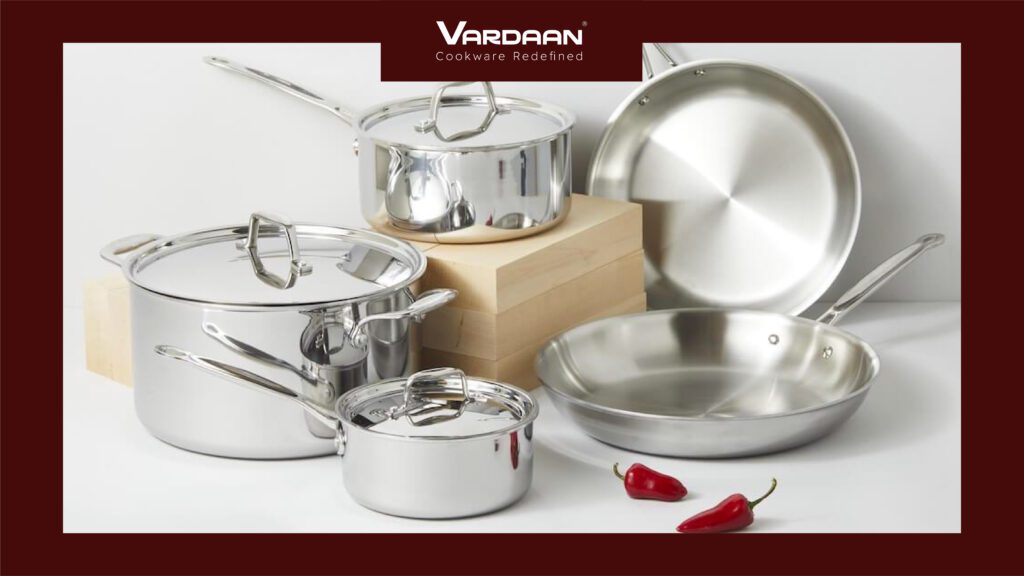
Sustainability and Health Aspects
Caring for stainless steel cookware doesn’t just mean tending to its maintenance, but also considering its environmental and health impacts. The metal is a more sustainable option than many due to its recyclability and durability, so it negates the need for frequent replacements. This means that less waste winds up in local landfills. In health terms, it also provides peace of mind. You don’t have to worry about it releasing harmful chemicals in your food like some non-stick coatings. Aluminum pans can also release chemicals when cooking acidic foods, like vinegar or tomatoes, so it’s just one more way to breathe easily. Because it’s non-reactive, it lets food hold onto its natural flavours and nutrients as well, which can create a healthier dining experience all around. Important to health as well as the health of the planet, stainless steel cookware is an option that fits neatly into a lifestyle that’s both sustainable and healthy.
Conclusion: Maximizing Your Stainless Steel Cookware’s Potential
Few materials can claim the benefits and versatility that stainless steel cookware delivers. The durability, non-reactivity, and ease of maintenance have given stainless steel a permanent place in every kitchen. Stainless steel cookware produces perfect sears on meats, brilliant browning on poultry, and masterful preparations of delicate sauces. It is ultimately the material of a thousand uses, encouraging the chef to embrace the boundless potential of the technology.
The journey of culinary discovery, then, can be one as simple as finding oneself. To create, to express, and to put forward that synthesis of pleasure and care into a sensory reality, to be both artist and cook, stainless steel cookware becomes the brave new frontier that invites the creative heart to take the leap and chart that unexplored territory. Vardaan suggests you take the plunge with their own line of high-quality stainless steel cookware. Visit them online at https://vardaancookware.com/ for the best stainless steel cookware options.
The care and maintenance of stainless steel cookware is as simple as the work you’ll make with it is beautiful. Simply clean with a good liquid detergent and apply a liquid polish, like Countertop, to maintain the lustre and shine of the metal. Never use steel wool or harsh abrasives, as they scratch and ruin the finish of the metal.

